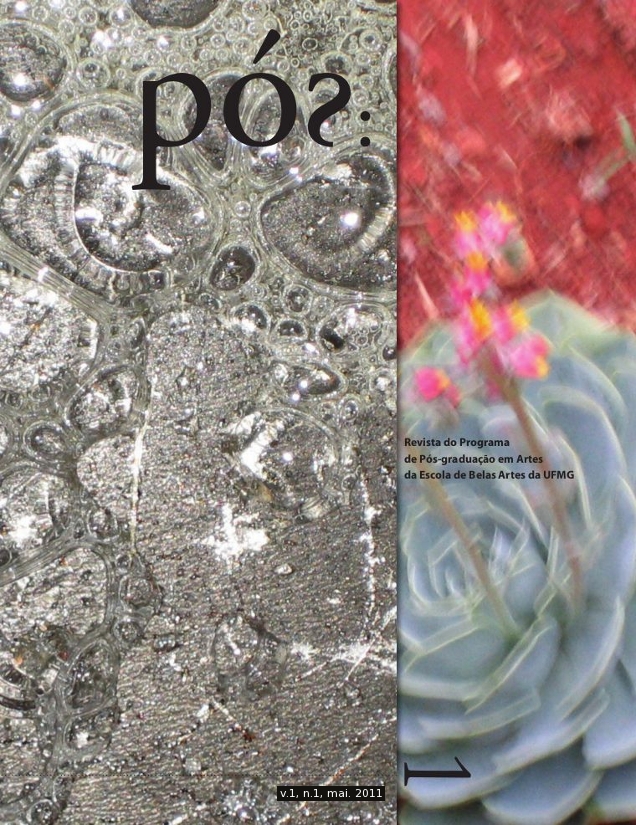The Technical Examination of a Painting that Passed through the Hands of Sienese Restorer and Forger Icilio Federico Joni
DOI:
https://doi.org/10.35699/2238-2046..48484Palavras-chave:
Artes - estudo e ensinoResumo
A panel painting of the Crucifixion belonging to the Fogg Art Museum and attributed to an imitator of the 14th-century northern Italian painter Altichiero was technically examined in order to address questions about its authenticity. Suspicions about the painting had been raised on technical grounds and because it was purchased from the famous Sienese restorer and forger Icilio Federico Joni (1866-1946). The materials and technique of the painting were studied and compared to 14th-century Italian panel painting practices and to restoration and forging techniques described by Joni. The examination shows that the distinction between a heavily restored painting and a fake can be ambiguous, particularly when only a vestige of the original remains. The issues raised when dealing with such ‘renovated ruins’, as well as the social context that created an environment conducive to the production and marketing of fakes in Italy in the late 19th and early 20th centuries, are also discussed.
Downloads
Referências
Anderson, J. 1994. A ‘most improper picture’: transformations of Bronzino’s erotic allegory. Apollo 139(384): 19-28.
Aronson, M. 2003. The conservation history of the early Italian collection at Yale. In Early Italian paintings: approaches to conservation. Proceedings of a symposium at the Yale University Art Gallery, April 2002, ed. P. S. Garland. New Haven: Yale University Art Gallery. 30-53.
Berrie, B. 1997. Prussian blue. In Artists’ pigments: a handbook of their history and characteristics, vol. 2, ed. E. West Fitzhugh. Washington D. C.: National Gallery of Art; New York: Oxford University Press. 191-217.
Bomford, D., J. Dunkerton, D. Gordon and A. Roy. 1989. Art in the making. Italian painting before 1400. London: National Gallery.
Bomford, D. 1994. Changing taste in the restoration of paintings. In Restoration: is it acceptable?, ed. A. Oddy. London: British Museum. 33-40.
Brandi, C. [1963] 1977. Teoria del restauro. Torino: Giulio Einaudi.
Bronk, H., S. Röhrs, A. Bjeoumikhov, N. Langhoff, J. Schmalz, R. Wedell, H.-E. Gorny, A. Herold and U. Wäldschlager. 2001. ArtTAX - a new mobile spectrometer for energy-dispersive micro X-ray fluorescence spectrometry on art and archaeological objects. Fresenius Journal of Analytical Chemistry 371: 307-16.
Catalano, M. I. 1998. Brandi e il restauro. Percorsi del pensiero. Fiesole: Nardini Editore.
Ciatti, M. 1990. Cleaning and retouching: an analytical review. In Cleaning, retouching and coatings, ed. J. S. Mills and P. Smith. London: International Institute for Conservation of Historic and Artistic Works. 59-62.
Cleveland Museum of Art website. www.clevelandart.org/explore/artistwork.asp?searchText=joni&tab=1&recNo=0&woRecNo=1(accessed August 2005).
Curatorial file 1965.85, Fogg Art Museum, Cambridge, Mass.
Exhibition of pictures of the school of Siena and examples of the minor arts of that city. 1904. London: Burlington Fine Arts Club.
Fredericksen, B. and F. Zeri. 1972. Census of pre-nineteenth century Italian paintings in North American public collections. Cambridge: Harvard University Press.
Frinta, M. 1982. Drawing the net closer: the case of Ilicio [sic] Federico Joni, painter of antique pictures. Pantheon 40(3): 217-24, 271-2.
Frinta, M. 1978. The quest for a restorer’s shop of beguiling invention: restorations and forgeries in Italian panel paintings. The Art Bulletin 58(1): 7-23.
Garland, P. S., ed. 2003. Early Italian paintings: approaches to conservation. Proceedings of a symposium at the Yale University Art Gallery, April 2002. New Haven: Yale University Art Gallery.
Gettens, R. J. and G. Stout. 1966. Painting materials: a short encyclopedia. New York: Dover Publications.
Hoeniger, C. 2003. Past and present in the restored early Italian image. In Early Italian paintings: approaches to conservation. Proceedings of a symposium at the Yale University Art Gallery, April 2002, ed. P. S. Garland. New Haven: Yale University Art Gallery. 277-84.
Hoeniger, C. 1999. The restoration of the early Italian ‘Primitives’ during the twentieth century: valuing art and its consequences. Journal of the American Institute for Conservation 38(2): 144-61.
Johnson, M. and E. Packard. 1971. Methods used for the identification of binding media in Italian paintings of the fifteenth and sixteenth centuries. Studies in Conservation 16(4): 145-64.
Jones, M., ed. 1990. Fake? The art of deception. London: British Museum.
Joni, I. F. 2004. Le Memorie di un pittore di quadri antichi (a fronte la versione in inglese ‘Affairs of a painter’). Siena: Protagon Editori.
Joni, I. F. 1936. Affairs of a painter. London: Faber and Faber.
Joni, I. F. 1932. Le memorie di un pittore di quadri antichi: con alcune descrizioni sulla pittura a tempera e sul modo di fare invecchiare i dipinti e le dorature. Florence: Società Editrice Toscana.
Khandekar, N. 2003. The preparation of cross-sections from easel paintings. Reviews in Conservation 4: 52-64.
Kühn, H. 1986. Zinc white. In Artists’ pigments: a handbook of their history and characteristics, vol. 1, ed. R. L. Feller. Washington D. C.: National Gallery of Art; Cambridge: Cambridge University Press. 169-86.
Kurz, O. 1967. Fakes. New York: Dover Publications.
Laver, M. Titanium dioxide whites. In Artists’ pigments: a handbook of their history and characteristics, vol. 3, ed. A. Roy. Washington D. C.: National Gallery of Art; New York: Oxford University Press. 295-355.
Longhi, R. 1968. Unpublished letter. Curatorial file 1965.85. Fogg Art
Museum, Cambridge, Mass.
Longhi, R. 1957. Guariento: un’opera difficile. Paragone 91: 37-40.
Martin, E. 1977. Some improvements in techniques of analysis of paint media. Studies in Conservation 22(2): 63-7.
Mazzoni, G. 2004. Falsi d’autore: Icilio Federico Joni e la cultura del falso tra Otto e Novecento. Siena: Protagon Editori.
Mazzoni, G. 2001. Quadri antichi del Novecento. Vicenza: Neri Pozza.
Meiss, M. 1966. Unpublished letter. Curatorial file 1965.85. Fogg Art Museum, Cambridge, Mass.
Mills, J. S. and R. White. 1987. The organic chemistry of museum objects. London: Butterworths.
Muir, K. 2003. The technical examination of the Fogg’s ‘Crucifixion’ panel painting attributed to an imitator of Altichiero. Unpublished Report. Straus Center for Conservation and Technical Studies, Harvard University Art Museums, Cambridge, Mass.
Natale, M. and C. Ritschard. 1997. L’art d’imiter: images de la renaissance italienne au Musée d’art et d’histoire. Geneva: Ville de Genève, Department des affaires culturelles.
Richards, J. 2000. Altichiero: an artist and his patrons in the Italian trecento. Cambridge and New York: Cambridge University Press.
Roy, A. and J. Dunkerton. 2003. Chemistry and conservation: changes in perception and practice at the National Gallery, London. In Early Italian paintings: approaches to conservation. Proceedings of a symposium at the Yale University Art Gallery, April 2002, ed. P. S. Garland. New Haven: Yale University Art Gallery. 120-31.
Schilling, M.R., H. P. Khanjian, and D. M. Carson. 1997. Fatty acid and glycerol content of lipids; effects of ageing and solvent extraction on the composition of oil paints. Technè: la science au service de l’histoire de l’art et des civilizations 5: 71-8.
Seymour Jr., C. 1970. Early Italian paintings in the Yale University Art Gallery. New Haven: Yale University Press.
Skaug, E. 1994. Punch marks from Giotto to Fra Angelico: attribution, chronology, and workshop relationship in Tuscan panel painting: with particular consideration to Florence, c. 1330-1430. Vol. 2. Oslo: IIC Nordic Group, the Norwegian section.
Strachey, B. and J. Samuels, eds. 1983. Mary Berenson: A self-portrait from her letters and diaries. New York; London: W.W. Norton and Company.
Zeri, F. 1968. Unpublished letter. Curatorial file 1965.85. Fogg Art Museum, Cambridge, Massachusetts.
Further Reading
Cennini, C. [c. 1954] 1960. The craftsman’s handbook. Trans. D. V. Thompson, Jr. New York: Dover.
Jones, M. and M. Spagnol, eds. 1993. Sembrare e non essere: i falsi nell’arte e nella civiltà. Milan: Longanesi.
Mazzoni, G. and A. Olivetti. 1993. Joni, deliberate counterfeiter or creative artist. The Art Newspaper 25 (Feb): 16-17.
Newberry, T., G. Bisacca and L. Kanter. 1990. Italian Renaissance frames. New York: Metropolitan Museum of Art.
Reed, C. 2004. Wrong! But a nice fake is a valued object in a university art museum. Harvard Magazine. 107/1. www.harvardmagazine.com/online/ 090432.html (accessed March 2005).
Siena tra Purismo e Liberty. 1988. Milan: A. Mondadori; Roma: De Luca. Thompson, D. V. [1936] 1962. The practice of tempera painting. New York: Dover Publications.
Downloads
Publicado
Edição
Seção
Licença

Este trabalho está licenciado sob uma licença Creative Commons Attribution-NonCommercial 4.0 International License.
Autores que publicam nesta revista concordam com os seguintes termos:
- Autores mantém os direitos autorais e concedem à revista o direito de primeira publicação, com o trabalho simultaneamente licenciado sob a Creative Commons Attribution-NonCommercial 4.0 International License que permite o compartilhamento do trabalho com reconhecimento da autoria e publicação inicial nesta revista.
- Autores têm autorização para assumir contratos adicionais separadamente, para distribuição não-exclusiva da versão do trabalho publicada nesta revista (ex.: publicar em repositório institucional ou como capítulo de livro), com reconhecimento de autoria e publicação inicial nesta revista.
- Autores têm permissão e são estimulados a publicar e distribuir seu trabalho online (ex.: em repositórios institucionais ou na sua página pessoal) a qualquer ponto antes ou durante o processo editorial, já que isso pode gerar alterações produtivas, bem como aumentar o impacto e a citação do trabalho publicado
- É responsabilidade dos autores a obtenção da permissão por escrito para usar em seus artigos materiais protegidos por lei de Direitos Autorais. A Revista PÓS não é responsável por quebras de direitos autorais feitas por seus colaboradores.












